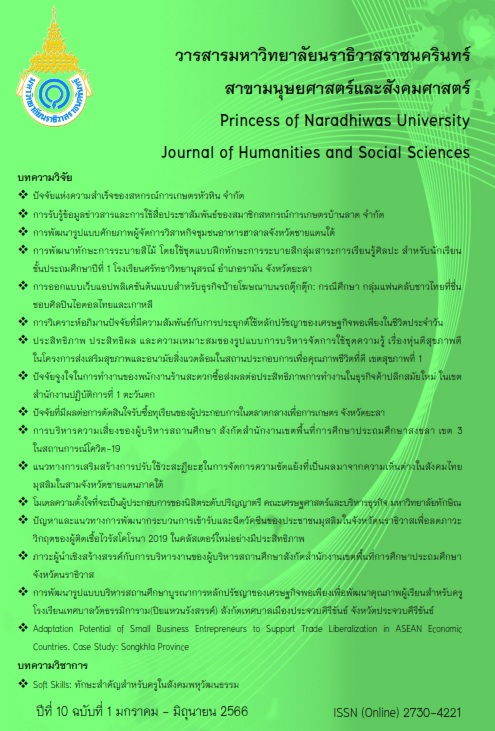The Efficiency, Effectiveness, and Appropriateness of the Management Model Based on Smart and Healthy Worker Knowledge Set in Health Promotion and Environmental Health Project in Workplaces for Good Quality of Life, Health Region 1
Main Article Content
Abstract
The purposes of this research were 1) To assess the efficiency, effectiveness, management and the use of health knowledge set about Smart and Healthy worker 2) To develop a management model using a health knowledge set about Smart and Healthy worker that was suitable with each establishment in the region. 3) To test the efficiency, effectiveness and suitability of project management by using the health knowledge set about Smart and Healthy worker in the context of the establishments in Health region1 by dividing the study into 3 steps: 1) Assessing efficiency, effectiveness, problems and obstacles with management, consisting of establishments in Chiang Mai, Lamphun, Lampang, Chiang Rai, Phayao, Phrae, Nan and Mae Hong Son provinces. The sample in the study were divided into 2 groups: The first group consisted of 92 people and 422 people for the second group; data were collected by using a test from the sample group. 2) Developing a management model using a health knowledge set about Smart and Healthy worker that was suitable with the establishments, and applied them in the preparation of management manual of Health Knowledge Packages 1 3) Test the efficiency, effectiveness and suitability of project management in which consisted of multi-stage randomization method of 146 samples in the study. The data were collected by using a test from the sample group and reviewing the appropriateness of the management model from 40 stakeholders and 12 experts. Moreover, they were analyzed by using statistical analysis of frequency, percentage, as well as mean and standard deviation.
The results of the research indicated that 1) For management aspect, it was found that the network of working groups at the district level, the provincial level and the leader of the establishment were efficient in terms of effectiveness, the environment was arranged to facilitate activities that promote good shape and good health of workers in the workplace. The average score of an efficiency of the project implementation was 2.86, and the average score of an effectiveness of workers’ application of the health knowledge set about Smart and Healthy worker was 2.85. 2) The management model consisted of the development of establishment’s leader, creation and development of leadership potential in establishment, behavior enhancement of workers to have good shapes and good health, support and motivate workers to participate in activities, and enhance the participation of all networking partners. 3) Testing the efficiency, effectiveness and appropriateness of management, the appropriateness of the project management style. These testing were consisted of the roles and duties of the leaders, participatory integrated work characteristics, factors supporting the project implementation, project implementation process with participative knowledge management, strengthening and developing leadership competencies, and following-up of the results.
Article Details

This work is licensed under a Creative Commons Attribution-NonCommercial-NoDerivatives 4.0 International License.
References
กมลทิพย์ วิจิตรสุนทรกุล. (2564). แนวโน้มปัจจัยเสี่ยงและพฤติกรรมเสี่ยงโรคไม่ติดต่อ พ.ศ. 2548-2558 จากการสำรวจพฤติกรรมเสี่ยงโรคไม่ติดต่อและการบาดเจ็บ: BRFSS. สืบค้นจาก http://www.thaincd.com/document/file/info/brfss/ผลการติดตามปัจจัยเสี่ยงและพฤติกรรมเสี่ยง-BRFSS.pdf.
กระทรวงสาธารณสุข. (2564). ระบบรายงานกลุ่มรายงานมาตรฐาน งานโภชนาการ HDC Tethered PHR. สืบค้นจาก https://hdcservice.moph.go.th/hdc/reports/page.php?cat_id=46522b5bd1e 06d24 a5bd81917257a93c
ดุจเดือน ปัญโยวัฒน์. (2562). กลยุทธ์การฝึกอบรมที่ส่งผลต่อประสิทธิภาพในการทางานของพนักงานระดับปฏิบัติการ ธนาคารเพื่อการเกษตรและสหกรณ์การเกษตร (วิทยานิพนธ์บริหารธุรกิจมหาบัณฑิต). มหาวิทยาลัยราชภัฏร้อยเอ็ด, ร้อยเอ็ด.
พนารัตน์ เจนจบ, วรรณภา ประทุมโทน, สมตระกูล ราศิริ, และพรเพ็ญ ภัทรากร. (2562). การประเมินส่งเสริมสุขภาพในสถานประกอบการในการขับเคลื่อนระบบสุขภาพชุมชน สู่ระบบสุขภาพอำเภอ เครือข่ายพยาบาล ภาคตะวันออก ประเทศไทย. วารสารวิจัยสุขภาพและการพยาบาล, 35(3), 91-94.
พิสณุ ฟองศรี. (2551). การเขียนรายงานประเมินโครงการ (พิมพ์ครั้งที่ 3). กรุงเทพฯ: เพชรรุ่ง.
วรรณภา ประทุมโทน, พนารัตน์ เจนจบ, สมตระกูล ราศิริ, และนันทวรรณ ธีรพงศ์. (2562). การพัฒนารูปแบบการส่งเสริมสุขภาพแบบมีส่วนร่วมต่อพฤติกรรมการส่งเสริมสุขภาพและสถานะสุขภาพของบุคลากร วิทยาลัยบรมราชชนนี. วารสารวิชาการสาธารณสุข, 28(พิเศษ), 96-108.
วริษฐ์ ทองจุไร. (2557). อิทธิพลของภาวะผู้นำการเปลี่ยนแปลง ความยึดหยุ่นเชิงกลยุทธ์ ศักยภาพด้านกระบวนการจัดการความรู้ และความสามารถในการบริหารการเปลี่ยนแปลงต่อประสิทธิผลขององค์การ (วิทยานิพนธ์ศิลปศาสตรมหาบัณฑิต). มหาวิทยาลัยศิลปากร, กรุงเทพฯ.
วุชธิตา คงดี. (2564) โรคปัจจุบันของกลุ่มคนวัยทำงานในโลกปัจจุบัน. สืบค้นจาก https://www.ogswa.or.th/17675458/health-promotion-for-jorpor-series-ep2
วิชัย เอกพลากร. (2557). การสำรวจสุขภาพประชาชนไทยโดยการตรวจร่างกาย (พิมพ์ครั้งที่ 5). กรุงเทพฯ: สถาบันวิจัยระบบสาธารณสุข.
ศักดิ์ชาย ควรระงับ. (2562). กระบวนการปรับเปลี่ยนพฤติกรรมเพื่อควบคุมน้ำหนักตัวของบุคลากรของมหาวิทยาลัยพายัพ. วารสารพยาบาลสาร, 41(1), 85-95.
สำนักงานสถิติแห่งชาติ กระทรวงดิจิทัลเพื่อเศรษฐกิจและสังคม. (2564). สรุปผลการสำรวจภาวะการทำงานของประชากร (เดือนมีนาคม พ.ศ.2563). สืบค้นจาก https://www.nso.go.th/sites/2014 /DocLib13/ด้านสังคม/สาขาแรงงาน/ภาวะการทำงานของประชากร/2563/Report_02-63.pdf
สำนักส่งเสริมสุขภาพ กรมอนามัย กระทรวงสาธารณสุข. (2562). คู่มือแนวทางส่งเสริมสุขภาพและอนามัยสิ่งแวดล้อมในสถานประกอบการ. กรุงเทพฯ: ชุมนุมสหกรณ์การเกษตรแห่งประเทศไทย.
อธิปพัฒน์ เดชขุนทด. (2558). อิทธิพลการจัดการในองค์การที่มีผลต่อประสิทธิผลในการปฏิบัติงานของบุคลากรโรงพยาบาลบางปะอิน (วิทยานิพนธ์บริหารธุรกิจมหาบัณฑิต). มหาวิทยาลัยรามคำแหง, กรุงเทพฯ.
อาภรณ์ อ่อนคง. (2565). ประสิทธิผล. สืบค้นจาก http://aporn123.blogspot.com/2013/06/blog-post _28.html
Cronbach, L. J. (1990). Essentials of psychological testing (5thed.). New York: Harper Collins Publishers.
Hoy, W.K, & Cecil G.M. (1991). Educational Administration: Theory Research and Practice. thed. New York: Harper Collins.
Ryan, T.A. and Smith, P.C. (1954). P.C. Principles of industrial Psychology. New York: The Ronald Press Company
Stufflebeam, D. L. (1983). The CIPP Model for Program Evaluation. Boston: Kluwer - Nijhoff.


